Semiotics explores the study of signs and symbols as essential elements of communication, revealing how meaning is constructed and interpreted across various contexts. This discipline examines the intricate relationship between the signifier, the signified, and the cultural codes that influence understanding. Discover how semiotics can deepen Your insight into language, media, and everyday interactions by reading the full article.
Table of Comparison
| Aspect | Semiotics | Rhetoric |
|---|---|---|
| Definition | Study of signs and symbols as elements of communication. | Art of persuasion through language and writing. |
| Focus | Meaning creation via signifier-signified relationships. | Effective argumentation and audience influence. |
| Key Theorists | Ferdinand de Saussure, Charles Sanders Peirce. | Aristotle, Cicero, Kenneth Burke. |
| Core Components | Sign, Signifier, Signified, Codes. | Ethos, Pathos, Logos. |
| Application | Textual analysis, cultural studies, media interpretation. | Speechwriting, literary criticism, advertising. |
| Goal | Decode meaning and cultural significance. | Persuade and motivate an audience. |
Introduction to Semiotics and Rhetoric
Semiotics explores the study of signs and symbols as fundamental elements of communication, analyzing how meaning is created and interpreted across languages, images, and gestures. Rhetoric focuses on the art of persuasion, employing strategies and techniques to influence an audience through effective communication. Understanding semiotics provides insights into the underlying structures of meaning, while rhetoric emphasizes the intentional use of language to achieve specific effects.
Defining Semiotics: The Study of Signs
Semiotics is the study of signs and symbols as elements of communicative behavior, analyzing how meaning is created and interpreted through sign processes known as semiosis. Unlike rhetoric, which focuses on persuasion and effective communication techniques, semiotics investigates the underlying structures and codes that govern meaning-making across languages, images, and cultural artifacts. Key theorists such as Ferdinand de Saussure and Charles Sanders Peirce established foundational models distinguishing between the signifier, signified, and the interpretant in semiotic analysis.
Understanding Rhetoric: The Art of Persuasion
Rhetoric is the art of persuasion that utilizes language, symbols, and techniques to influence an audience's beliefs or actions. Unlike semiotics, which studies signs and meanings independently of intent, rhetoric emphasizes strategic communication designed to persuade or motivate. Mastering rhetorical devices such as ethos, pathos, and logos enables effective argumentation and audience engagement in written and spoken discourse.
Historical Evolution of Semiotics and Rhetoric
Semiotics originated with Ferdinand de Saussure and Charles Sanders Peirce in the early 20th century, evolving as the study of signs and symbols within cultural and linguistic contexts. Rhetoric, dating back to ancient Greece, was formalized by Aristotle as the art of persuasion through ethos, pathos, and logos in public speaking and writing. While semiotics expanded to analyze broader sign systems in communication, rhetoric traditionally centered on structuring arguments and influencing audiences through language.
Key Theorists and Foundational Concepts
Ferdinand de Saussure and Charles Sanders Peirce are pivotal figures in semiotics, with Saussure introducing the dyadic model of the sign (signifier and signified) and Peirce developing a triadic model (representamen, object, interpretant). In rhetoric, Aristotle, Cicero, and Kenneth Burke stand out, emphasizing persuasive appeals through ethos, pathos, and logos, as well as the art of effective communication and symbolic action. Semiotics primarily examines signs and meaning-making, whereas rhetoric focuses on persuasion and audience impact within discourse.
Semiotic Analysis vs Rhetorical Analysis
Semiotic analysis deciphers meaning through signs, symbols, and codes within texts, revealing cultural and contextual layers that shape understanding. Rhetorical analysis examines how language and persuasive techniques influence audiences, focusing on ethos, pathos, and logos to evaluate argument effectiveness. While semiotics decodes underlying meanings embedded in communication systems, rhetoric assesses strategic language use to persuade and impact interpretation.
Applications in Media and Communication
Semiotics decodes the signs and symbols within media content to reveal underlying cultural meanings, enabling communicators to craft messages that resonate on a deeper level with diverse audiences. Rhetoric emphasizes persuasive strategies and techniques, guiding the construction of compelling narratives to influence public opinion and behavior effectively. In media and communication, integrating semiotic analysis with rhetorical methods enhances message clarity, audience engagement, and interpretive richness across platforms such as advertising, journalism, and digital storytelling.
Overlapping Territories and Distinctions
Semiotics and rhetoric intersect in their analysis of signs and meaning-making processes, with semiotics focusing on the study of signs and symbols in communication, while rhetoric emphasizes persuasive language and techniques. Both disciplines explore how meaning is constructed and interpreted, yet semiotics applies to a broader range of sign systems beyond language, including images and gestures, whereas rhetoric traditionally targets spoken and written discourse designed to influence audiences. This overlap highlights the semiotic foundation of rhetorical strategies, but the distinction remains in semiotics' wider scope of signification versus rhetoric's goal-oriented communication tactics.
Practical Implications in Modern Discourse
Semiotics, the study of signs and symbols, decodes meaning in communication by analyzing how signs relate to their objects and interpretants, enabling a deep understanding of cultural and social messages. Rhetoric, centered on persuasive techniques and effective argumentation, shapes discourse by crafting messages that influence audiences' beliefs and actions. In modern discourse, combining semiotic analysis with rhetorical strategies enhances critical media literacy, allowing individuals to both interpret underlying messages and strategically communicate for impact in advertising, politics, and social movements.
Conclusion: Integrating Semiotics and Rhetoric
Integrating semiotics and rhetoric enhances communication by combining the study of signs and symbols with persuasive strategies, creating more impactful messages. Understanding semiotic elements such as icons, indexes, and symbols enriches rhetorical appeals, enabling speakers and writers to engage audiences on deeper cognitive and emotional levels. The synergy of these disciplines fosters effective meaning-making and persuasion across diverse communicative contexts.
Semiotics Infographic

 libterm.com
libterm.com